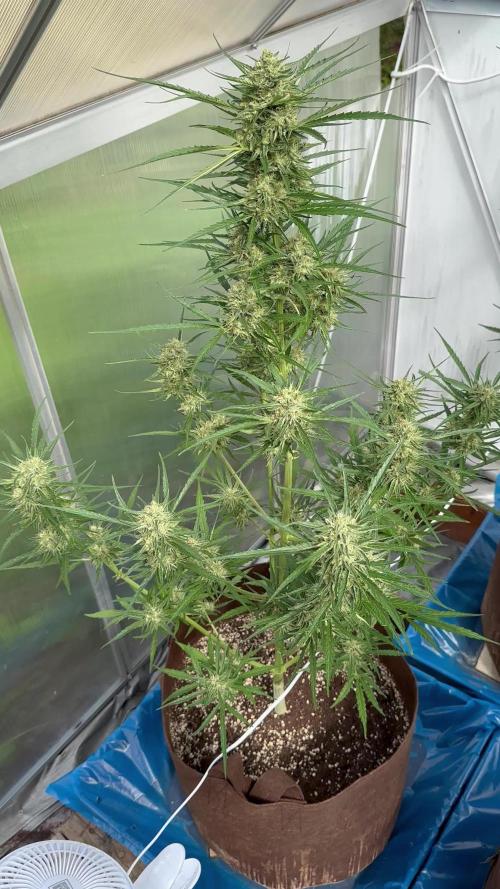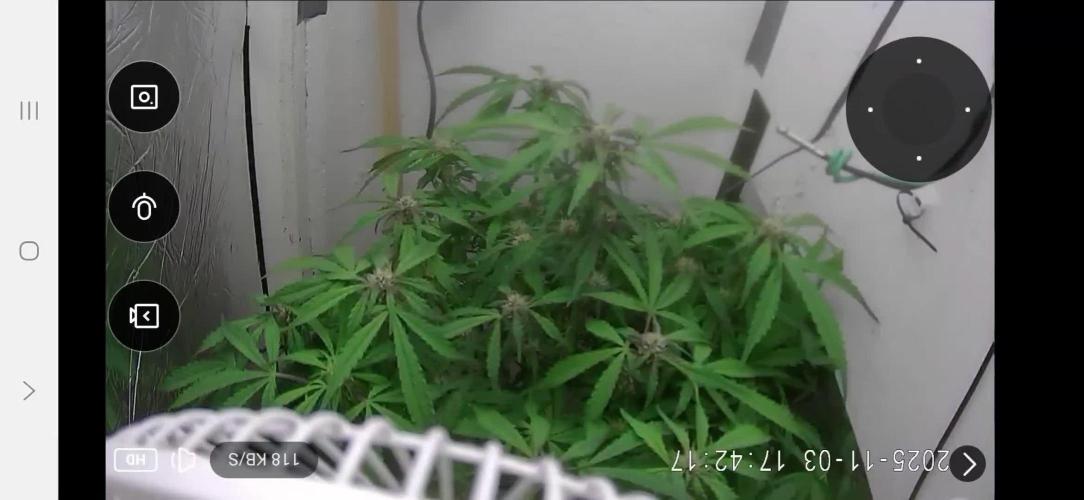The Grow Awards 2026 🏆 































Likes
Comments
Share


@BigDaddyK
Follow
Adding some PK ....to one on the left - one on right is about 2 weeks behind
Change reservoir Monday’s
Likes
3
Share


@Seeds_growforgreen
Follow
Beautiful blooming Golf ball size..🏑⚾️
Nutrients Plagron on bloom is very very good. 👌
Alga Bloom 4ml/l 🍡🥜
Royal Sugar 1ml/l 🍭🍯
Green Sensation 1ml/l 🥦
Likes
23
Share


@Piorkeed
Follow
Tenth week of flowering started.
I went out a week and at my return I discovered that the #2 is sick. The plant doesn't drink anymore and a lot of branches are falling down with limp leaves. I think that the missing defoliation, the height and the poor ventilation caused that. At the moment I removed her from the tent moving her out to the balcony.
I did a huge defoliation to the #1 and a massive LST in order to low the height of buds that reached the lamp that is at its maximum height.
So far I gave to the plant only water.
I think that the cause of plant disease is the high humidity level (at least 90%...). Tomorrow I will buy a dehumidifier hoping that this will help the remaining plant.
D63: changed the water into the pot. Added 15 ml grow, 30ml micro and 40ml bloom. [email protected] EC 1.2
D64: after the defoliation the plant seems to be healthy. The humidity into the tent is still high, tomorrow I will install the dehumidifier.
D65: I've put a dehumidifier into the tent, I've added 3 liters of tap water to the pot; the plant is drinking a lot so I think that she is fine. The plants produces a lot of fat buds, so I've checked the trichomes for the first time, they are clear for the majority.
D67: added 5 liters of tap water to the pot. The plant is drinking a lot
Likes
42
Share


@DogDoctorOfficial
Follow
Yup as i suspected the defoliation, despise on her case a almost no leafs one since she is an auto and she was on her first week flowering, but she did took it like the champ she is and she is aiming to the moon as i like them to do, her bud formation is peculiar and beautiful to my eyes <3 <3 <3 i think i am in live with this Lavender, big shout out to the @SeedsMafia on this outstanding creation of them, very exited to see what she will tell me next <3 <3 <3
As always thank you all for stopping by and for supporting me on this journey, i am super passion about growing and fell blessed to have you all with me on this new journey <3 <3 <3
Genetics -Seeds Mafia Lavender Automatic
Light - LUMATEK ZEUS 465 COMPACT PRO
Food - APTUS HOLLAND
All info and full product details can be find in can find @
https://seedsmafia.com
https://aptus-holland.com/
https://autopot.co.uk/
https://lumatek-lighting.com/
<3 <3 <3 Growers love to you all <3 <3 <3
Auto Lavender Feminized is a very popular type of cannabis, whose strong therapeutic effects are highly appreciated. It has a flowering period of approximately 9-10 weeks and can be grown both indoors and outdoors. It is a resistant variety which can be cared for easily.
This variety is mostly appreciated because it produces strong, durable and resistant plants. Its branches and stem usually grow vertically rather than horizontally. It reaches heights of 120 cm and the harvests amount to 90 grams/plant. In addition, it contains high levels of THC- up to 20%.
As their name suggests, the plants that grow from Auto Lavender Feminized seeds have a smell and taste similar to those of lavender, also comprising mint and rosemary tones. This is a variety of cannabis that is usually appreciated for its pleasant fragrance and high productivity, seeing as its buds and stem produce an impressive quantity of resin. If you’re looking for another kind of feminized, autoflowering variety, Auto Lavender Feminized will not disappoint you for sure!
auto Lavender Feminized is a feminized, autoflowering variety, obtained by crossing the Lavender and Lowryder 2 species. The plants that grow from this variety have a very specific structure: they are tall, vigorous, and have large branches. At the end of the flowering period, the plants acquire an orange-gold shade
Likes
21
Share


@reirrac1
Follow
Decided after seeing the improvement in the Tangerine Dream to continue with the new feeding schedule, which will include a flush in a few days. She got pretty burnt from the salt based nutes, but her flowers have thickened up considerable over the last few days so I will try to get as much out of her as possible. NCH x SB trichomes are finally beginning to fill out with milk, and several sugar leaves have already gone 30% amber. One more week of flushing and I think I’ll chop her down. Feed pH 6.5, EC 0.9. Flush pH 6.2, EC 0.3.
Likes
12
Share


@Socal6pak
Follow
LOOKS GOOD. GROWING STEAD. NOTHING OUT OF ORDINARY. HAVN'T SEEN MANY PESTS EXCEPT LEAF HOPPERS. WILL PROBABLY NEED TO SPRAY IN JULY TO KEEP CATEPILLARS AND APHIDS OFF.
ALL 4 SIMILAR SIZES. NO MUTATED OR SHRIVELED FAN LEAVES. SINCE OUTDOORS. IM NOT GONNA TRAIN TOO MUCH THIS TIME. SINCE THE SUN WILL HIT IT FROM ALL DIRECTIONS. LET'S KEEP HANDS OFF AND SEE HOW IT GROWS.
Likes
14
Share


@SBCannabisCo
Follow
Enjoyed this run. Ready to harvest in about 1 and a half weeks, I actually have seeds in a couple of the plants. It happens, this is my first indoor grow so, need to get my hand on some new genetics
Likes
21
Share


@BruWeed
Follow
Esta planta estuvo dos semanas en etapa de enraizamiento, tres en crecimiento y ocho semanas en floración.
No tuvo ningún problema con nada, me resultó de fácil cultivo.
En esta cosecha obtuve ciento cuarenta y siete g en total.
Utilice una maceta Root House de 10L.
El sustracto que utilice fue de Nube Verde, en su composición se incluye turba de categoría, perlita, humus, compost, tierra, dolomita y vermiculita.
Sin duda volvería a probar esta genética otra vez, supero mis expectativas.
Likes
14
Share


@Canadian
Follow
This girl has been cruising through no issues the smell typical hockey Moby Dick thank you for reading I will continue to update have a happy grow.
Likes
74
Share


@Sillyasswhitedude
Follow
The THC Bomb auto is taking her sweet time...I am gonna let her....I will get some green pics up and update later...making a run to the garden supply store today...HAPPY GROWING EVERYONE!!!! Made it to the garden store at 4:20pm they closed at 4pm...Luckily the owner was still there doing paper work and let me in...got soil for my next grow and some other odds and ends...a lot of cool stuff in there and I will be making some upgrades as my budget allows
9-11 Thc Bomb Auto is at 73 days today buds are still swelling trichs are 5% amber at best I have been flushing and feeding only water since day 60...I'm gonna let her go the distance!!! I have 2 surviving Bubble Bomb clones and their mother is thriving since her move outside...ill get pics of her later...
9-13 Harvested the thc bomb auto all day yesterday...the surviving lady left in this grow is Bubble Bomb and her clones...I'm going to run those in their own diary and clone them again unless anyone objects or I get raided but run the Bubble Bomb Fem out right here...she is getting huge...im runnin her in a scrog because she is way too tall and were I come from you don't wanna be seen in public with a fat girl if you catch my drift...she is 75 days today and just started to grow hair...Ill train her down as much as I can in the next week or so...first full 12 hours of darkness is sept 25 here...im gonna heavy feed her until then...Happy Growing!!!!!
Likes
36
Share


@SAC87
Follow
Day 14 flower
Hey Growers
So day 14 of flower, I decided to defoliate as the tent was getting so overgrown. They are drying out quickly and the media is dense with roots. They are going to require daily watering very shortly. They seem quite happy and doing well. You can see in one of the pictures, the leaf edge is raised, which idk exactly what that is. I’ve decreased the light to 70% until I know how they’ll react.
Other than that just put in the trellis to support the tops.
Happy Growing 🌱
Likes
23
Share


@HideAndFly420
Follow
Great réaction to stress.
Flow exactly started thé 28th day.
Let’s see.
Started bio bloom too.
Likes
2
Share


@CuriosityWebster
Follow
Went away for seven days had a friend come by and water the garden
Absolutely exploded since I’ve seen them last very pleased with all of the plants except for mystery auto number one. It is disappointing me some but hopefully the top will bring more growth.
Can’t wait to see these continued to develop!!!
Likes
46
Share


@Seedler
Follow
WELL! What an experience.
I made some mistakes, learned a lot and still got some excellent weed out of it.
Super frosty, LOUD and SO dense it's ridiculous 😂
Sadly i got some (a lot for me) mold, i encountered for the very first time. With it being almost winter in Germany, the temps dropped really hard for some days and then even 60% humidity was too much for the strain. I also would say it isn't that resistant against mold, so just keep that in mind, the buds are so dense, it's really easy for them to trap water.
I had to throw away like 1/4 of the yield, mostly the top buds 💀 That kinda sucked, but it could be worse, it's fire weed tho, i'll add pictures of the buds later.
Likes
22
Share


@donovanliam
Follow
Not much to update getting close to harvest trichomes are looking cloudy buds are pretty dense and sticky. Smells pretty pungent skunky with alittle citrus.
Likes
11
Share


@SubliminalSociety
Follow
F*CK MENSTRUAL CRAMPS!
Purplematic is a high CBD, low THC strain by RQS. It helps with pain management without getting you high as a kite, ie it's great to battle those monthly belly cramps. It has become my wife's favourite F*CK MENSTRUAL CRAMPS strain.
We use it to make edibles and tinctures. So, a little goes a long way. Rather than pushing for yield, we focus on getting one big fat juicy sticky cola.
ITS FAST - 8-9 weeks from seed to harvest
ITS BEAUTIFUL - the buds get a nice purple color with light brown pistils
IT WORKS - follow our journey to make the best anti cramps medicine!





















